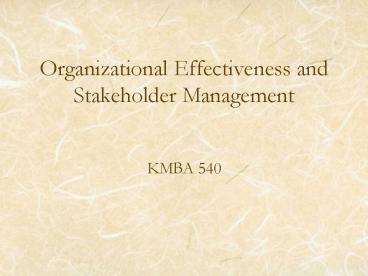Organizational Effectiveness and Stakeholder Management PowerPoint PPT Presentation
1 / 21
Title: Organizational Effectiveness and Stakeholder Management
1
Organizational Effectiveness and Stakeholder
Management
- KMBA 540
2
Definitions of Organizations
- Social entity, goal directed, deliberately
structured, identifiable boundaries (Daft) - Response to and means of creating value that
satisfies human needs. Embodies collective
knowledge, values, and vision (Jones) - Integration of specialized knowledge bases into a
common task (Drucker)
3
Organizations
- Human creations whose operations and products are
results of the ways we govern them and of the
social, institutional, and political structures
within which they operate (i.e., their
environments) - Organizations are both products of these
structures and de-stabilizers of these structures
4
Trends and Tensions in Contemporary Organizations
- What do you think are the most significant
challenges organizations are facing today?
5
Essential Features of Organizations
- Open system input, transformation, output
- Subsystems boundary spanning, production,
maintenance, adaptation, management - Domains range of products and services produced
(functions) for serving markets and customers - Environmental Transactions dealing with factors
outside the organizational boundaries
6
Open Systems View of Organization
ENVIRONMENT
Raw Materials Resources
Products Services
Output
Transformation
Input
Organization
Production Maintenance Adaptation Management
Boundary Spanning
Boundary Spanning
Subsystems
7
Assessing Organizational Effectiveness
- Goals approach
- Achieving organizational goals is being effective
- Official Goals Mission (broad and long term)
provide legitimacy to public - Operative Goals specific goals that direct
behavior in the short term (what organizations
are really doing) - Official and operative goals often differ (e.g.,
higher education prisons Wal-Mart)
8
What are the benefits of setting goals?
- Guidelines for action
- Serve as constraints on actions
- Source of legitimacy
- Serve as standards for performance
- Source of motivation
- Rationale for organizing
9
Areas of Organizational Goal Setting
- Management Performance and Development
- Employee Performance and Development
- Social Responsibility
- Market goals
- Innovation
- Productivity
- Physical and Financial Resources
- Profitability
10
Problems with Goal Approach
- Multiple goals are set that conflict
- Whose goals receive priority?
- When should goals change?
- Individuals set goals not organizations process
is political - Goals are set and pursued through complex
processes of bargaining among powerful coalitions
of individuals in organizations
11
Assessing Organizational Effectiveness
- External resource approach
- Evaluation of a firms ability to manage and
control external environment - Obtaining scarce and valued inputs
- Measured by quality and costs of inputs stock
price quality of products/ services ROI - Example Software firm hires the best engineers
with competitive compensation university
acquiring research faculty
12
Assessing Organizational Effectiveness
- Internal Systems Approach
- Innovation and quick response to changes
- Measured by decision making time, product
innovation rate, time to get new products to
market, reduction of conflict and motivation
problems - Example 3M 25 of sales must come from
products less than 5 years old
13
Assessing Organizational Effectiveness
- Technical efficiency approach
- Ability to convert skills and resources into
goods and services efficiently - Measured by rate of reduction of defects,
reduction of product costs and delivery times,
increases in customer service and product quality - Example TQM processes at Stanley Engineering
Six Sigma Process at Motorola and GE
14
Balanced Scorecard
15
Areas of Balanced Scorecard
- Financial
- Cash flow analysis, income statement, balance
sheet, financial ratios, budgets, EVA analyses - Customer
- Monitor customer service, defections, changes in
quality of customer - Quality
- TQM, business process re-engineering, Six Sigma,
waste prevention/reduction - Employee Performance
- Performance evaluation methods
16
Assessing Organizational Effectiveness
- Stakeholder Approach
- Stakeholders are any individuals, groups, or
organizations that have an interest in the firms
activities and ultimate survival - Internal stakeholders owners or shareholders,
employees, and managers - External stakeholders customers, suppliers,
government, unions, local community, general
public, natural environment
17
Managing Stakeholders
- Inducements and contributions balance
- Inducements are what the firm provides for
stakeholder (e.g., employees receive wages) - Contributions are what the stakeholder provides
for the firm (e.g., employees provide effort,
knowledge, physical labor, etc.) - Firms would like to provide as little inducement
as possible for adequate levels of stakeholder
contribution and vice versa
18
Managing Stakeholders
- Assess importance of stakeholders
- Power, legitimate rights, and urgency
- Assess potential for threat vs. potential for
cooperation - Opportunity, capacity, and willingness
- Determine appropriate strategies for managing the
stakeholder
19
Potential for Threat
Low
High
Supportive Stakeholder Get Involvement
Mixed Blessing Stakeholder Collaborative
strategies
High
Potential for Cooperation
Non-supportive Stakeholder Defensive strategies
Marginal Stakeholder Monitor
Low
Fringe stakeholders?
20
Managing Fringe Stakeholders
- Radical Transactiveness (RT)
- Dynamic capability of organizations to identify,
explore, and integrate stakeholders on the
fringe poor, isolated, weak, non-legitimate,
and non-human - Result competitive imagination
- Generate disruptive innovations and creative
destruction for imagining new business
possibilities - Capabilities Fan out and Fan in
21
Managing Stakeholders
- Managing multiple goals of stakeholders
- setting priorities or preference ordering
- sequential attention
- bargaining and compromise
- satisficing
- At least minimal satisfaction of all current
stakeholders is organizational effectiveness.

